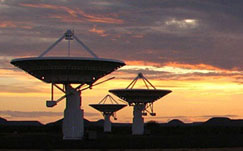South Africa's trek to the start of time
8 October 2010
It will be capable of probing the edges of our universe. It will search for gravitational waves, predicted but never detected. It will be a virtual time machine, enabling scientists to explore the origins of galaxies, stars and planets. And South Africans are at the heart of its development.
 Allied with eight other African countries, South Africa is competing against Australia (allied with New Zealand) to host the €1.5-billion Square Kilometre Array (SKA), an instrument 50-100 times more sensitive and 10 000 times faster than any radio imaging telescope yet built.
Allied with eight other African countries, South Africa is competing against Australia (allied with New Zealand) to host the €1.5-billion Square Kilometre Array (SKA), an instrument 50-100 times more sensitive and 10 000 times faster than any radio imaging telescope yet built.
The international SKA consortium is due to announce the winning bid in 2012, with construction likely to start in 2014 and finish by about 2022.
The completed telescope will comprise around 3 000 antennas with a combined collecting area of roughly one square kilometre.
South Africa plans to locate the core of these in the Karoo region of the Northern Cape – an arid, remote area blessed with exceptionally clear skies and minimal radio interference – with outlying stations in Botswana, Ghana, Kenya, Madagascar, Mauritius, Mozambique, Namibia and Zambia.
The country is no newcomer to major league astronomy. The Northern Cape is already home to one of the world's largest telescopes, the Southern African Large Telescope or SALT.
South Africa also works closely with neighbour Nambia on the HESS gamma ray telescope, and is currently building an 80-dish precursor instrument for the SKA, the Karoo Array Telescope (also known as the MeerKAT), due to be commissioned in 2014/15 as the most sensitive radio telescope in the Southern Hemisphere.
In the process, South African engineers are already working on some of the SKA's technological building blocks – such as a prototype dish antenna that combines new materials with innovative design processes to meet the SKA's exacting precision, durability and cost criteria.
If awarded to South Africa, the SKA would establish the southern African region as a major international astronomy hub.
And the SKA consortium, comprising 55 institutions in 19 countries, is optimistic that the United States will be part of the project.
In its latest report to the US National Research Council, released in August, the US Committee for a Decadal Survey of Astronomy and Astrophysics endorsed the SKA, expressing "unqualified enthusiasm for the science that this facility could deliver and recognition that it represents the long-term future of radio astronomy."
This does not automatically translate into the 40% funding the SKA partners were hoping the US would provide. The committee noted that the SKA schedule and the US funding timetable are out of synch.
At the same time, it urged funding for two other projects – HERA (Hydrogen Epoch of Reionization Array) and NANOGrav (North American Nanohertz Observatory for Gravitational Waves) – that could greatly assist the SKA.
Responding to the report, SKA project director Richard Schilizzi said: "We are cautiously optimistic that the US will take part in the SKA."
This article was first published in South Africa Now, a six-page supplement to the Washington Post produced on behalf of Brand South Africa. Download South Africa Now (PDF, 2.12 MB).









 Facebook
Facebook Twitter
Twitter Mobile
Mobile RSS feeds
RSS feeds Newsletter
Newsletter Weblines
Weblines